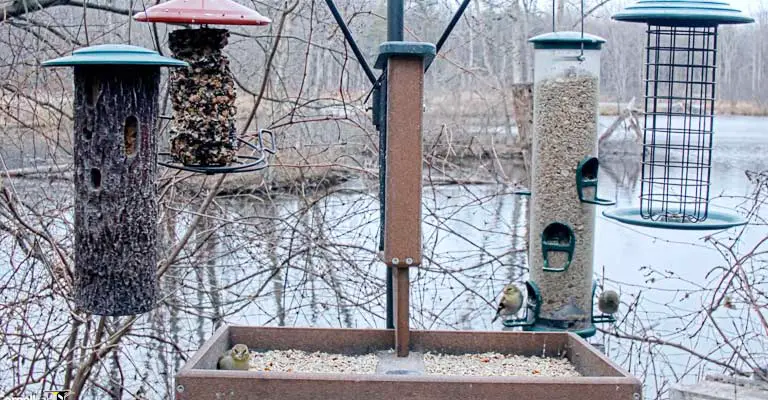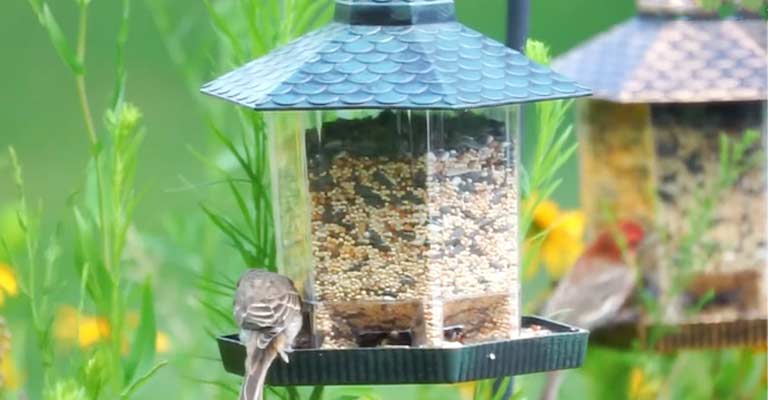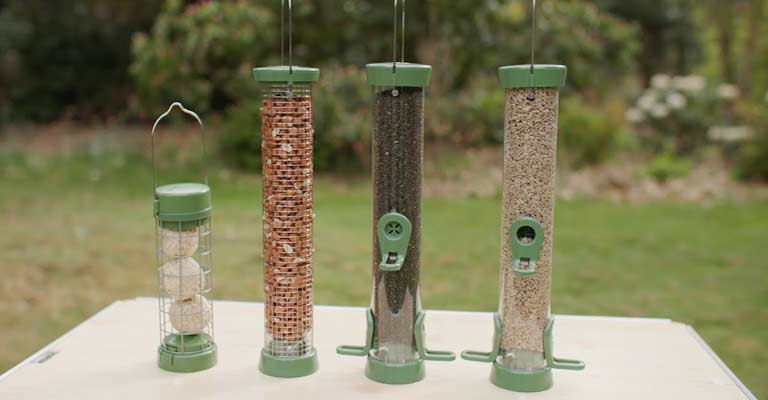Embarking on the journey of attracting birds to a new feeder is a rewarding endeavor, transforming your outdoor space into a vibrant haven of avian activity.
While the prospect is exciting, the initial response from birds may require a delicate approach. Understanding the intricacies of avian behavior and preferences is essential for a successful transition.
This guide explores seven effective strategies to attract birds to a new feeder, ensuring a harmonious coexistence between bird enthusiasts and the diverse avian community.

Attract Birds To A New Feeder
Welcoming birds to a new feeder is a rewarding experience, transforming your space into a vibrant haven of avian activity. To entice feathered visitors, it’s essential to employ strategies that capture their attention and cater to their preferences.
Here are seven effective ways to attract birds to a new feeder
Strategic Placement
Position the feeder in a visible and safe location, preferably near trees or shrubs where birds can perch and observe. Providing a sense of security encourages birds to explore and frequent the new feeding station.
Quality Bird Food
Offer a variety of high-quality bird food, such as black oil sunflower seeds, thistle seeds, and suet. A diverse menu caters to different bird species, ensuring a broader range of visitors to your newly installed feeder.
Gradual Introduction
Introduce the new feeder gradually by placing familiar food near it. As birds associate the area with a reliable food source, they’ll become more comfortable exploring the new feeder, increasing the chances of regular visits.
Clean and Fresh
Keep the feeder clean and regularly refill it with fresh food. Birds are more likely to return to a well-maintained and hygienic feeding station, ensuring they associate it with a consistently reliable food source.
Water Source Nearby
Provide a nearby water source, like a birdbath or small fountain. Birds are attracted to both food and water and having a water feature in proximity enhances the overall appeal of the feeding area.
Offer Shelter
Place the feeder near natural shelters, like trees or bushes, to provide birds with a quick escape route if they sense danger. Having a safe and sheltered environment encourages birds to visit the feeder more frequently.
Patience and Observation
Be patient and observe the surroundings. Spend time quietly watching the feeder area, allowing birds to acclimate to the new addition. Patience is key as birds gradually become accustomed to the feeder’s presence.
What Kind Of Bird Feeder Attracts The Most Birds?

Selecting the right bird feeder can significantly influence the variety of feathered visitors to your backyard. To maximize the appeal and cater to diverse bird species, it’s essential to choose feeders that accommodate different feeding styles.
Here are the types of bird feeders known to attract a wide range of birds:
Tube Feeders
Tube feeders with multiple perches and feeding ports attract small to medium-sized birds like finches, chickadees, and sparrows. Their design allows for easy access to seeds while preventing larger birds from dominating the feeding space.
Hopper Feeders
Hopper feeders, often mounted on a pole or suspended, appeal to various bird species. With a reservoir to hold a generous amount of seed, these feeders are favored by cardinals, jays, and doves due to their open design and larger perching areas.
Platform Feeders
Ideal for ground-feeding birds, platform feeders accommodate species like juncos, towhees, and mourning doves. They offer a flat surface for easy access to seeds and are suitable for both small and larger bird species.
Suet Feeders
Suet feeders attract insect-eating birds like woodpeckers, nuthatches, and chickadees. These feeders hold blocks of suet, providing a high-energy food source, especially during colder months when birds need extra calories.
Nyjer (Thistle) Seed Feeders
Designed specifically for tiny seeds like thistle, these feeders attract finches, siskins, and goldfinches. The small ports and perches make it challenging for larger birds to access, ensuring a dedicated space for smaller, more colorful species.
Hummingbird Feeders
Hummingbird feeders with bright red accents attract these iridescent wonders. The nectar-filled reservoir and small feeding ports cater exclusively to hummingbirds, adding a dynamic and vibrant element to your bird-friendly space.
Mealworm Feeders
Ideal for attracting bluebirds, robins, and other insect-loving birds, mealworm feeders provide a reliable source of live or dried mealworms. This feeder type caters to birds that prefer protein-rich food sources.
What Do You Do If Birds Won’t Like Its New Feeder?

Introducing a new feeder to your backyard can be an exciting venture, but there’s a possibility that birds might not immediately embrace the change. Patience and thoughtful adjustments are key to ensuring the success of your new feeder.
Here are the tips on what to do if birds seem reluctant to use their new feeding station:
Familiar Food Placement
Start by placing familiar food near the new feeder. This helps birds associate the area with a reliable food source, gradually building their confidence in exploring the new feeding station.
Gradual Introduction
Introduce the new feeder gradually by hanging it alongside existing feeders. Birds are more likely to investigate when the new addition is placed within their familiar feeding territory.
Strategic Placement
Ensure the new feeder is strategically placed, visible, and easily accessible. Positioning it near natural cover like trees or bushes provides birds with a sense of security, encouraging them to approach.
Similar Design
If possible, choose a feeder with a design similar to those already in use. Birds may be more inclined to explore a feeder that resembles the ones they are accustomed to using.
Use Preferred Foods
Offer the birds’ favorite foods in the new feeder. Whether it’s sunflower seeds, suet, or thistle, using preferred foods increases the likelihood that birds will be attracted to and utilize the new feeding station.
Patient Observation
Spend time quietly observing the feeding area. Birds can be cautious, and your presence may initially deter them. Patience and stillness allow birds to acclimate, increasing the chances of them accepting the new feeder.
Modify Perches and Accessibility
Adjust the feeder’s perches and accessibility. Ensure that perches are appropriately spaced and accommodate different bird sizes. Some modifications may encourage birds to explore and use the new feeder more readily.
By implementing these tips, you can create a positive and gradual transition for birds to embrace the new feeder.
Remember that birds can be cautious about changes in their environment, so providing a familiar and enticing setup encourages their trust and eventual acceptance of the new feeding station.
FAQs
What can I do if birds aren’t using the new feeder?
Start by placing familiar food near the new feeder and gradually introducing it. Ensure its strategic placement, mimicking the surroundings of existing feeders, and be patient as birds acclimate to the change.
Should I change the type of food to attract more birds?
Yes, offering a variety of preferred foods, such as sunflower seeds or suet, can attract different bird species. Experiment with food types to see what appeals to the local bird population.
Is there an optimal time of day to attract birds to the new feeder?
Morning and late afternoon are typically the most active times for bird feeding. However, birds may visit throughout the day, so observation during different hours is advisable.
Can the design of the feeder impact bird attraction?
Yes, choose a feeder design similar to existing ones in your yard. Birds may be more comfortable with a familiar-looking feeder, making them more likely to investigate and use it.
How can I encourage shy birds to visit the new feeder?
Provide cover near the feeder, like shrubs or trees, giving shy birds a sense of security. Offering their preferred foods and maintaining a quiet observation distance helps build their confidence.
Conclusion
Attracting birds to a new feeder is a gradual process that demands patience and thoughtful consideration.
By strategically placing feeders, providing familiar foods, and offering a secure environment, you lay the foundation for a thriving bird-friendly space.
The joy of witnessing diverse bird species frequenting your feeder is not just a testament to successful attraction but also a testament to the creation of a welcoming and nurturing habitat.
As the feathered guests become familiar and trusting, the new feeder becomes a central hub for avian activity, enriching the outdoor experience for both birds and bird enthusiasts alike.